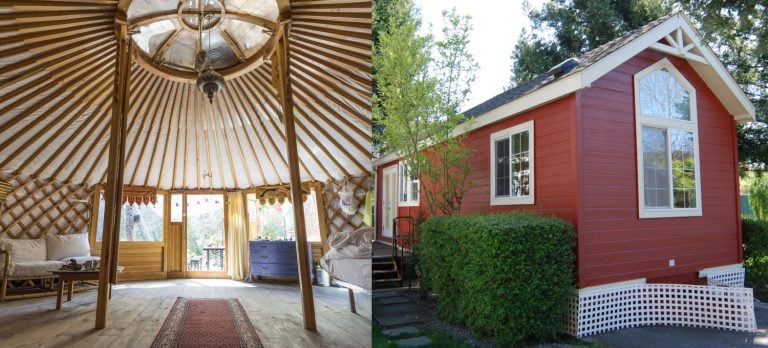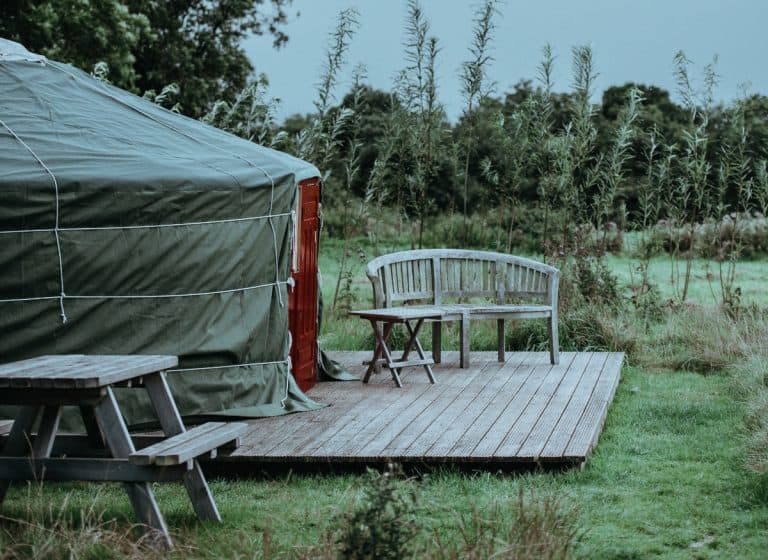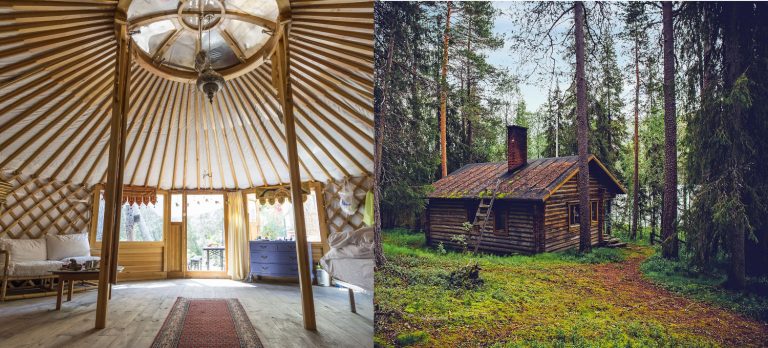Can You Live In a Yurt Full Time?
Many of us are downsizing during these trying times. Some do it out of necessity, others to free themselves from excessive financial obligations.
Most people downsize to smaller houses, but others take the opportunity to make much more fundamental lifestyle changes. Why live in a house when you can keep your living cost to a minimum by moving into a yurt? If you are among these potential front runners, you may wonder if it is even realistic to live in a yurt full-time.
It is possible to live in a yurt full time. Mongolians and other Central Asian peoples have done this for millennia. For those who prefer a little more comfort, it is also possible to live a modern life with modern conveniences in a yurt, including privacy and running water.
Let us go through the challenges and opportunities related to yurt-living.
Winter and Hot Weather
The first question that many people ask when they consider living in yurt year round is whether they will be able to stay warm during winter.
I have already covered this subject in a separate article, and the short answer is that you can absolutely live in a yurt during even very cold winters. On the Mongolian steppes, where the yurt originates, winter nights often go below minus 40 degrees Fahrenheit (-40 degrees Celcius), yet the nomads can stay nice and warm inside their yurts.
But Mongolia is not all frozen tundra. The continental climate causes significant temperature swings, and summers can reach temperatures of over 100 degrees Fahrenheit (38 degrees Celcius). Therefore the original yurt design was made to provide a comfortable home in both hot and cold climates.
The key to keeping a comfortable temperature inside the yurt is insulation. Efficient insulation will make any winter bearable or even comfortable, and during hot summers, insulation helps to keep the temperature down inside the yurt. Another important element is the top dome that can be opened to allow a steady airflow. And if you live in a very hot climate, nothing would prevent you from installing an A/C unit.
Utilities
Many yurt owners live off-grid. Sometimes because they live remotely and have no other options besides moving closer to a town. But more and more people live off-grid out of choice and a desire to be independent. Yurt-dwellers tend to fall into this category, but if you do prefer living on the grid, this is also a possibility as yurts can be connected to municipal utilities just like a house.
Let us look into how yurts can (and often do) come with modern amenities.
Heat
Yurts are traditionally kept warm by a wood stove, but you could use electric heating if you prefer an easier solution.
Central heating is very uncommon – partly because it takes up a lot of space and requires elaborate heating systems that are not practical or necessary in such small homes. Another reason that central heating is so uncommon may also have something to do with the fact that people often choose to live in a yurt because they prefer a simple life.
Plumbing and sanitation
While more and more people prefer to do without modern conveniences, running water is often the last to go. Most of us want a hot shower, tap water, and an indoor toilet.
While these luxuries are not very common (or practical) to nomadic people, modern yurts often offer these conveniences. As these yurts are not made to be disassembled on a regular basis, running pipes from the municipal pipeline is no less challenging than connecting a house to the grid. In fact, bathrooms are very common in yurts that are intended as permanent structures.
Electricity
Almost all yurt owners in western countries utilize electricity in one way or another. Some are connected to the grid, while others utilize solar panels or wind turbines. Outlets can be installed where needed.
Privacy
One commonly stated reason why families and couples decide to live full-time in a yurt, is to get closer to each other and spend more time together. But we all occasionally need our own space, perhaps to focus on work or just for some alone-time. Or perhaps you are living with roommates and prefer individual bedrooms.
When several people live together in a small yurt, privacy can be hard to find, but 25-foot yurts or bigger are large enough for room partitions. Add a few free-standing walls or solid walls to divide your home into separate rooms.
The legality of Living in a Yurt
All homes, including yurts, are subject to local laws and regulations. In particular zoning and building codes.
One important matter is how local authorities define a home. Someone setting up a yurt in their backyard may have to consider rules that relate to tents and camping, which are often (but not always) less restrictive. But if you decide to set up a yurt on undeveloped land with the intent to live in it full-time, you may have to apply for building permits and abide by building codes.
If you wish to live full-time in a yurt, prepare to spend some time looking into local regulations.
Security and Theft
All else being equal, a yurt is slightly less safe against burglars compared to most houses. Of course, yurts are not as safe against intruders as a brick-built home, but they are much safer than most people believe them to be.
Unlike a tent, yurts are protected by wooden lattice walls and a thick layer of felt and canvas. While it is possible to cut your way through the cover and break the walls, this is not a quick process and requires some determination. This is not wildly different from breaking through wood sidings on a mobile home.
The door is also commonly as solid as the doors on most ordinary houses. Just make sure to attach it firmly to the walls and install a solid lock.
If you own valuable items or sentimental value items, I recommend you buy a quality safe and bolt it to the floor. You can also install security systems, such as alarms and outside cameras that will warn you if an uninvited guest shows up.
Generally, I would not worry more about burglaries or personal safety while living in a yurt than a mobile home or even a house. Just make sure to take the necessary precautions that everybody should take regardless of where they live.
Space and Storage
Large yurts provide up to around 2,000 square feet of floor space, which is equivalent to a medium-sized house, in which case space should not be an issue. However, most people go with yurts in the 260 to 730 square feet-range, which requires more efficient space management.
Moving into a yurt can be seen as an opportunity to downsize, not only in terms of home size but also by minimizing your amount of stuff. A lot of what we own, we never use, so why not sell it or give it away?
Another solution is to build a storage shed. This could be something as simple as a shipping container. These containers are solid, rust-resistant, and very difficult to break into. If you really need a lot of space, you can also group two or more yurts and set up a connecting tunnel. Some people do this to separate the toilet from the main section, but it could also be used as additional storage space.
How are Yurts Different From a House?
As you can see, yurt-living a be very primitive but it can also include all the modern conveniences we are used to. It really is up to you and what you prefer… And the local regulations, of course.
Then why live full-time in a yurt instead of a house? What is the difference
One difference is the low price. A good yurt costs about $12,000 while a very large luxury model will run you about $30,000. This is significantly less than a house in most locations, even if we include additional costs, such as running water and drain pipes into your yurt. Imagine the freedom of living debt-free in your own home.
Yurts also provide a sense of closeness to nature. Inside a house, you are sheltered from the creation surrounding it, whereas yurts are more akin to living in a luxury tent. You are still safe from severe weather, but you can hear the wind and the wild animals. You always know what the weather is like even while sitting comfortably by yur woodstove.
What’s not to love?


![How Do Yurts Hold Up In Storms? [Life-Saving Facts!]](https://freedomresidence.com/wp-content/uploads/2022/05/How-Do-Yurts-Hold-Up-In-Storms-768x512.jpg)


![Do Yurts Get Moldy? [3 Life-Saving Tips!]](https://freedomresidence.com/wp-content/uploads/2022/05/Do-Yurts-Get-Moldy-768x512.jpg)
